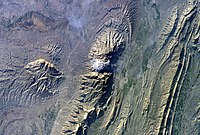Salt dome

Imagine a big bucket full of sand. If you stick a scoop into the bucket and pull it up, you can see a pile of sand in the scoop. Now, imagine if instead of sand, the bucket was full of salt. When you scoop out a big scoop of salt and pull it up, you can see a dome-shaped pile of salt in the scoop. That’s what a salt dome is— a big, round, hill-like structure made entirely out of salt.
But where does all this salt come from? A long time ago, there were vast oceans in places where there is now land. These oceans had lots and lots of salt dissolved in them. Over time, the water evaporated or dried up, leaving all the salt behind. This leftover salt got buried deep under the ground by lots of layers of rocks and earth.
Sometimes, because of underground pressure, the salt pushes up through these layers until it forms a high dome-shaped structure. Salt domes can be really big or really small, and they can be found in different parts of the world.
Because of their unique geochemistry, salt domes can also hold valuable materials like oil and gas. People can drill into the salt dome and extract these resources. But, salt domes can also be dangerous because they can shift or even collapse. It’s important to study them and make sure people and the environment are safe around them.
But where does all this salt come from? A long time ago, there were vast oceans in places where there is now land. These oceans had lots and lots of salt dissolved in them. Over time, the water evaporated or dried up, leaving all the salt behind. This leftover salt got buried deep under the ground by lots of layers of rocks and earth.
Sometimes, because of underground pressure, the salt pushes up through these layers until it forms a high dome-shaped structure. Salt domes can be really big or really small, and they can be found in different parts of the world.
Because of their unique geochemistry, salt domes can also hold valuable materials like oil and gas. People can drill into the salt dome and extract these resources. But, salt domes can also be dangerous because they can shift or even collapse. It’s important to study them and make sure people and the environment are safe around them.
Related topics others have asked about:
